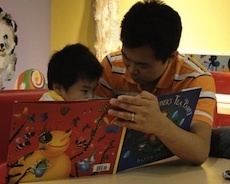 Last month, we released the results of our first QuickStudy on e-books. This report, “Teacher Attitude about Digital Games in the Classroom,” was inspired by the continued growth of e-readers — the Kindles, Nooks, and iPads that are almost ubiquitous now — and the exploding popularity of e-books for children.
Last month, we released the results of our first QuickStudy on e-books. This report, “Teacher Attitude about Digital Games in the Classroom,” was inspired by the continued growth of e-readers — the Kindles, Nooks, and iPads that are almost ubiquitous now — and the exploding popularity of e-books for children.
At the Cooney Center, we study how children’s learning is impacted by the technologies that surround them. There’s no doubt that kids are drawn to digital media — we’ve all seen toddlers who are not just mesmerized by iPhones and iPads, but able to navigate these devices expertly enough todownload their own apps (to the chagrin of their parents). Our own research has shown that the number of apps claiming to be “educational” has continued to climb to astronomical heights within the iTunes store in the five years since the iPhone was introduced (see ILearn II).
We couldn’t help but notice that e-books have been heralded as a new way of increasing literacy among young children. Fueled by growing interest from parents, publishers have embraced the format, and developers have begun creating e-books that are as lively and interactive as games. We were inspired too, in part, by articles in the press that point towards a sort of backlash among parents who are choosing to stick to traditional printbooks for their children, even if they are avid users of digital devices themselves. Parents have been quoted citing the tactile nature of print books and the “cuddle factor” as a reason to stick to bound books. So we set out to compare, contrast, observe, and ask questions about the ways adults and children engage with traditional print books, as well as basic or enhanced (more dynamic) e-books.
None of us are surprised that our humble little report has made such a splash. We knew we were being provocative when we titled our report “Print Books vs. E-books”, so we haven’t been shocked by headlines that sought to polarize a debate, as if reading print vs. e-books is a choice between “good” or “bad” (“Enhanced ebooks are bad for children finds American study,” shouted the Guardian.) But what these headline writers may not have understood was that this particular study didn’t seek to raise one medium over another, or even attempt to get at the question of whether parents or children prefer one format over another.
At the Cooney Center, one of our major lines of inquiry is focused around intergenerational learning and play. Over the past few decades, researchers have documented that children whose parents watch programs like Sesame Street with them, and talk about what is happening on screen while they are co-viewing the shows together, learn more than children who watch television without adult engagement. This understanding has led to even more research into early childhood development and learning to create children’s programming that is not just entertaining, but has the potential to teach young children whose time in front of the television is scaffolded by adults who talk about what they are seeing.
The new co–viewing involves parents and children engaging with digital media across more platforms — so in this vein, the goal of this study was to measure levels of engagement — between parent and child, and with the book itself. What kinds of interactions take place between parent and child when they are reading a print book, versus an e-book? How do they talk about the story and illustrations? Are there facets about the tactile experience of reading — turning the pages, or pressing buttons that are perhaps similar across platforms, or are they unique to each medium? And do the children remember the details of the story as well across different formats? How much do they learn as they read print books compared to e-books?
The findings of our study may not strike some readers as a complete surprise. It may seem evident, as some writers have pointed out, that e-books with bells and whistles like animations and games may be distracting to young readers. But the point of undertaking such research is not to underscore the obvious or to promote one medium over another. As Lisa Guernsey, author of Screen Time and director of the Early Education Initiative at the New America Foundation writes, we can make all sorts of assumptions about technology and how it might impact young children’s development — but until there is more research that actually digs into these issues, we simply don‘t have the evidence to confirm these assertions.
Our goal at the Cooney Center is to foster a productive dialogue about digital media and our kids. We developed the QuickStudy format as a way of rapidly investigating a research issue that we are interested in pursuing — quickly and inexpensively. For this particular study, our sample size is modest, and perhaps not as diverse as we would have liked. But it opens a window on the conversation, and we hope that it will inspire other researchers to jump in and conduct even larger-scale investigations. In turn, authors, developers, and publishers will be able to take advantage of this growing body of research to design their books to achieve purposeful engagement between adults and children co-readers; and parents, who only want the best for their children, will be inspired to think even more carefully about the types of interactions they are likely to have with a text across different media.




